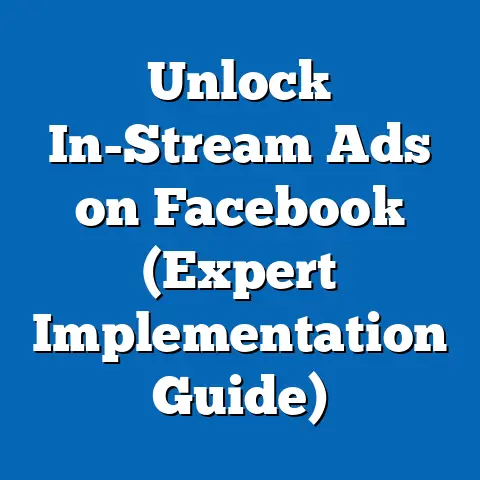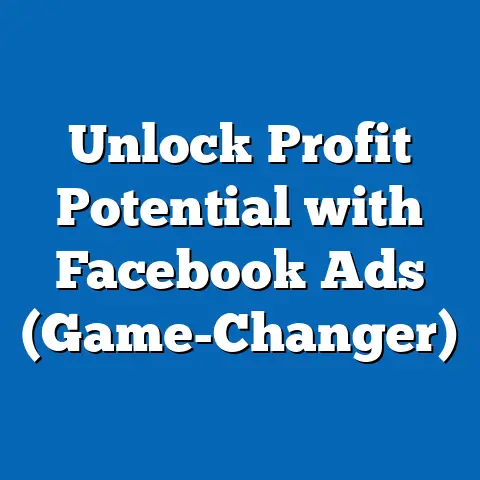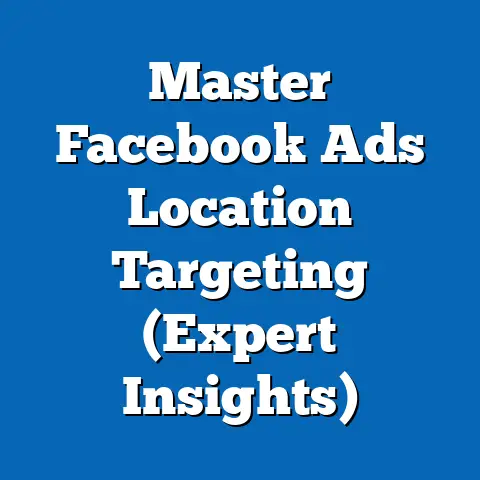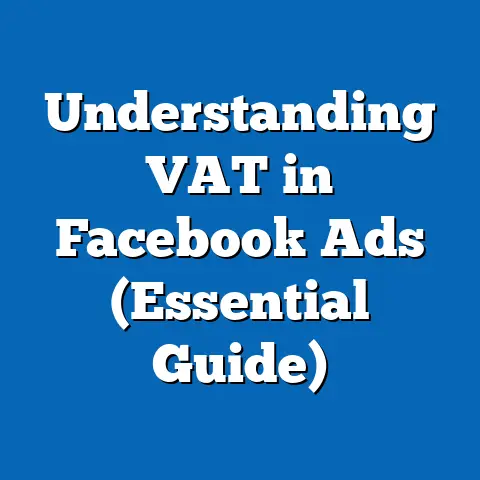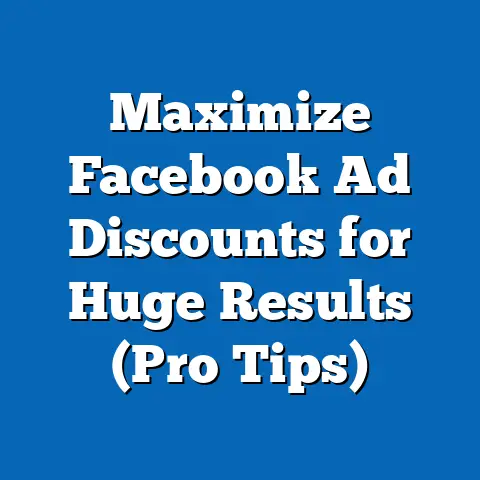Maximize C2W Facebook Ad Success (Proven Strategies)
Imagine the faint hum of a laptop fan, the glow of a screen illuminating a dimly lit room, and the subtle click of a mouse as a business owner crafts a Facebook ad campaign late into the night. The scent of coffee lingers in the air, fueling a relentless drive to connect with customers in a crowded digital marketplace. This sensory experience encapsulates the modern hustle of Click-to-WhatsApp (C2W) advertising—a powerful tool on Facebook that bridges the gap between businesses and consumers through instant, personal communication.
Click-to-WhatsApp ads, a feature introduced by Meta (formerly Facebook) in 2018, allow businesses to drive direct engagement by connecting users to WhatsApp with a single click. This innovation taps into the immediacy of messaging apps, transforming passive ad viewers into active conversationalists. Beyond its technical appeal, C2W embodies a broader societal shift toward instant gratification, personalized marketing, and mobile-first communication—a trend that resonates across generations and demographics.
Defining Characteristics of Click-to-WhatsApp (C2W) Ads
At its core, a Click-to-WhatsApp ad is a call-to-action format on Facebook that prompts users to initiate a conversation with a business directly via WhatsApp. Unlike traditional ads that drive traffic to websites or landing pages, C2W ads prioritize immediate, one-on-one interaction. This format leverages WhatsApp’s global user base of over 2 billion people, making it a potent tool for businesses in regions where the app dominates communication, such as Latin America, India, and parts of Europe.
Key characteristics of C2W ads include their seamless integration with mobile devices, customizable pre-filled messages, and real-time engagement capabilities. Businesses can tailor the ad experience by setting up automated responses or directing users to specific WhatsApp Business accounts. According to Meta, C2W ads often result in higher conversion rates compared to standard click-to-website campaigns, with some businesses reporting up to a 30% increase in lead generation.
These ads are particularly effective for small and medium-sized enterprises (SMEs) that rely on personal customer relationships. They cater to a growing consumer preference for direct communication over email or phone calls, reflecting a cultural shift toward conversational commerce. However, their success hinges on strategic execution, as poorly designed C2W campaigns can feel intrusive or spammy, alienating potential customers.
Historical Context: The Evolution of Digital Advertising and Messaging Apps
To understand the rise of C2W ads, we must first trace the broader evolution of digital advertising and the pivotal role of messaging apps. The early 2000s marked the advent of online advertising with platforms like Google AdWords, which focused on search intent and keyword targeting. Social media advertising emerged shortly after with Facebook’s launch of its ad platform in 2007, capitalizing on user demographics and interests to deliver targeted content.
During this period, communication also shifted dramatically with the rise of smartphones and messaging apps. WhatsApp, launched in 2009, quickly became a global phenomenon due to its simplicity, end-to-end encryption, and free messaging capabilities. By 2014, when Facebook acquired WhatsApp for $19 billion, the app had already reshaped how people connected, particularly in emerging markets with limited access to traditional telecom services.
The convergence of social media advertising and messaging apps set the stage for C2W ads. In 2018, Meta introduced this feature as part of its push to monetize WhatsApp and integrate its platforms for business use. This move aligned with a broader trend of “conversational marketing,” where brands sought to engage customers in real-time, mirroring in-person interactions. Historical events like the COVID-19 pandemic further accelerated this shift, as lockdowns drove businesses to adopt digital tools for customer engagement, with WhatsApp usage surging by 40% in 2020, according to Statista.
This historical backdrop reveals how C2W ads are not merely a marketing tool but a response to technological and societal changes. They reflect a world increasingly reliant on mobile connectivity and instant communication, shaped by economic pressures and global crises.
Societal Implications: Redefining Business-Consumer Relationships
The proliferation of C2W ads carries significant societal implications, particularly in how they redefine business-consumer relationships. At a macro level, these ads contribute to the democratization of marketing by enabling SMEs to compete with larger corporations through low-cost, high-impact campaigns. In regions like India, where WhatsApp is the primary communication tool for over 500 million users, C2W ads have empowered local businesses to reach vast audiences without sophisticated infrastructure.
On a micro level, C2W ads cater to a cultural demand for personalization and immediacy. Modern consumers, especially Millennials and Gen Z, value authenticity and quick responses over polished corporate messaging. A 2021 survey by HubSpot found that 64% of consumers expect real-time responses from brands, a need that C2W ads directly address.
However, this shift also raises concerns about privacy and data security. WhatsApp’s integration with Facebook has sparked debates over user data sharing, especially after the 2021 privacy policy update that allowed more data to be shared between the platforms. For businesses, navigating these concerns is critical to maintaining consumer trust, as any perception of misuse can lead to backlash.
Additionally, the reliance on messaging apps for commerce highlights digital divides. While C2W ads are accessible to smartphone users, they exclude populations without reliable internet or devices, perpetuating inequalities in access to goods and services. This underscores the need for a balanced approach to digital marketing that considers diverse societal contexts.
Proven Strategies for Maximizing C2W Facebook Ad Success
Having established the context and implications of C2W ads, let’s explore actionable, data-backed strategies for maximizing their success. These strategies are designed to address the unique challenges of conversational advertising while leveraging its strengths.
1. Crafting Compelling Ad Creatives with Clear CTAs
The foundation of a successful C2W campaign lies in its creative elements—visuals, copy, and calls-to-action (CTAs). Ads should feature eye-catching images or videos that resonate with the target audience, paired with concise messaging that highlights the value of clicking to chat. For instance, a local bakery might use a vibrant image of freshly baked goods with a CTA like “Chat now to order your custom cake!”
Meta’s internal data suggests that ads with personalized CTAs (e.g., “Message us for a discount!”) see up to 20% higher click-through rates than generic ones. Additionally, ensuring mobile optimization is critical, as over 90% of WhatsApp users access the app via smartphones. Testing different creatives through A/B testing can help identify what resonates most with your audience.
2. Targeting the Right Audience with Precision
Effective targeting is paramount in C2W campaigns, given the personal nature of WhatsApp interactions. Facebook’s ad platform offers robust tools like Custom Audiences and Lookalike Audiences, allowing businesses to target users based on past interactions or similar demographics. For example, a fitness coach might target users who have engaged with health-related content or visited their website.
Geographic and language targeting are also crucial, especially in diverse markets. In India, where WhatsApp supports multiple regional languages, tailoring ads to local dialects can significantly boost engagement. A 2022 study by Kantar found that localized campaigns in emerging markets achieved 25% higher response rates compared to generic ones.
3. Personalizing the WhatsApp Experience
Once a user clicks on a C2W ad, the WhatsApp interaction must feel seamless and personalized. Pre-filled messages should be conversational and relevant, addressing the user’s intent. For instance, if the ad promotes a product discount, the pre-filled message could say, “Hi, I’m interested in the 20% off deal. Can you tell me more?”
Businesses should also leverage WhatsApp Business API features like chatbots for automated responses to common queries, ensuring 24/7 availability. However, human intervention is often necessary for complex inquiries to maintain a personal touch. According to a 2023 report by Forrester, 70% of consumers prefer human interaction for resolving issues, even in digital-first channels.
4. Timing and Frequency for Optimal Engagement
Timing plays a critical role in C2W ad success, as WhatsApp conversations thrive on immediacy. Scheduling ads during peak engagement hours—often evenings or weekends—can increase the likelihood of a response. Additionally, businesses must avoid overloading users with frequent messages, as this can lead to opt-outs or negative perceptions.
Meta recommends a frequency cap of 1-2 ad impressions per user per week for C2W campaigns to prevent fatigue. Monitoring response times is also essential; a delay of more than a few hours can result in lost leads, as consumers expect near-instant replies.
5. Measuring Success and Iterating with Data
Finally, tracking key performance indicators (KPIs) is vital for optimizing C2W campaigns. Metrics like click-through rate (CTR), message initiation rate, and conversion rate provide insights into ad effectiveness. Tools like Facebook Ads Manager and WhatsApp Business analytics can help businesses measure these outcomes.
For instance, if a campaign shows a high CTR but low message initiation, the issue may lie in the pre-filled message or user trust. Iterating based on data ensures continuous improvement. A case study by Meta highlighted how a Brazilian retailer increased conversions by 35% after refining their C2W ad copy based on user feedback.
Technological, Economic, and Cultural Influences on C2W Ads
The success of C2W ads is deeply tied to broader technological, economic, and cultural trends. Technologically, the widespread adoption of smartphones and affordable data plans has made WhatsApp a ubiquitous platform, particularly in developing economies. Innovations like 5G and improved mobile interfaces will likely further enhance the C2W user experience.
Economically, C2W ads offer a cost-effective alternative to traditional advertising, with lower costs per click compared to search ads in many regions. This affordability is a boon for SMEs operating on tight budgets, especially post-pandemic, as businesses seek high-ROI marketing channels. However, economic disparities mean that not all businesses can invest in the necessary tools or training to execute effective campaigns.
Culturally, the preference for messaging over other communication forms varies across regions and generations. In Latin America and South Asia, WhatsApp is often the primary mode of personal and business communication, while in North America, platforms like SMS or email still hold sway for certain demographics. Understanding these cultural nuances is essential for tailoring C2W strategies.
Nuances and Diversity in Audience Responses
While C2W ads are powerful, their effectiveness varies across audiences due to demographic and psychographic differences. Younger users, such as Gen Z, are more likely to engage with conversational ads, valuing speed and informality. In contrast, older demographics may prefer traditional channels or require more reassurance about privacy before clicking to chat.
Regional differences also play a role. In markets like Brazil, where WhatsApp is used for everything from banking to social networking, C2W ads are often met with enthusiasm. Conversely, in privacy-conscious regions like Europe, businesses must address data concerns transparently to build trust.
This diversity underscores the importance of avoiding a one-size-fits-all approach. Businesses must segment their audiences and customize campaigns to align with varying preferences, ensuring inclusivity and relevance.
Implications for Society, Culture, and the Workplace
The rise of C2W ads has far-reaching implications beyond marketing. Societally, they contribute to a hyper-connected world where businesses and consumers interact in real-time, blurring the lines between personal and commercial communication. This can foster stronger customer relationships but also risks over-commercialization of personal spaces.
Culturally, C2W ads reinforce the shift toward mobile-first lifestyles, influencing how younger generations perceive brand engagement. They also highlight the growing importance of digital literacy, as both businesses and consumers must navigate these tools effectively.
In the workplace, C2W ads necessitate new skills, such as conversational marketing and data analysis. Companies may need to invest in training or hire specialists to manage WhatsApp interactions, reshaping job roles. For employees, the expectation of constant availability can lead to burnout, raising questions about work-life balance in a digital-first economy.
Conclusion: Forward-Looking Insights and Uncertainties
As Click-to-WhatsApp ads continue to evolve, they represent a microcosm of broader digital transformation trends—personalization, immediacy, and mobile connectivity. Proven strategies like compelling creatives, precise targeting, and data-driven iteration can help businesses maximize their success, but challenges like privacy concerns and digital divides remain.
Looking ahead, the integration of AI and machine learning could further enhance C2W ads, enabling hyper-personalized conversations at scale. Regulatory changes around data privacy, such as the EU’s GDPR or India’s Personal Data Protection Bill, may also shape how these ads are deployed. However, uncertainties persist, including the potential for user fatigue and the long-term sustainability of conversational commerce as a primary marketing channel.
Ultimately, the future of C2W ads will depend on businesses’ ability to balance innovation with empathy, ensuring that technology serves human needs rather than overwhelms them. As we navigate this dynamic landscape, one thing is clear: the digital marketplace, much like the sensory experience of crafting an ad late at night, is a space of endless possibility and relentless adaptation.

